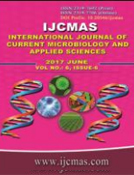


 National Academy of Agricultural Sciences (NAAS)
National Academy of Agricultural Sciences (NAAS)

|
PRINT ISSN : 2319-7692
Online ISSN : 2319-7706 Issues : 12 per year Publisher : Excellent Publishers Email : editorijcmas@gmail.com / submit@ijcmas.com Editor-in-chief: Dr.M.Prakash Index Copernicus ICV 2018: 95.39 NAAS RATING 2020: 5.38 |
Fungal keratitis is a major ophthalmic problem. In view of the importance in timely diagnosis and treatment of keratitis which would otherwise lead to serious complications like loss of vision, hypopyon formation, endopthalamitis, etc., this study was intended to bring into light the fungal etiological agents in suppurative keratitis. The specimen was collected from suppurative keratitis cases irrespective of prior antibiotic treatment during the period of one year from March 2012 to February 2013. Those cases with loss of corneal epithelium with signs of inflammation, and stromal infiltration were taken as suppurative keratitis cases. Five or more corneal scrapings are to be taken, based on the condition of the patient. The corneal scrapings are used for 10% KOH mount and Gram staining. Sabouraud’s Dextrose Agar (SDA) is inoculated by touching the medium with the needle. Extreme care is taken to keep the entire process sterile. During the one-year period, out of the 100 patients with suppurative keratitis, there were 56 (82.36%) fungal isolates. Aspergillus spp. was the commonest, constituting 22 (39.29%) of the total fungal isolates. Fusarium is the second most common in this study 9(16.7%). Although corneal ulceration is a very rare cause of mortality, it is one of the important causes of morbidity and disability in South Kerala, especially among lower socio-economic groups. The present study gives an insight about the fungal aetiological agents of suppurative keratitis in this part of Kerala. The results of this study are similar to that in other parts of India. These findings have important public health implications for the treatment and prevention of corneal ulceration in the developing world.
 |
 |
 |
 |
 |